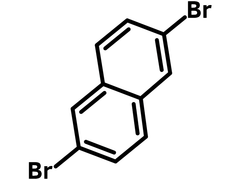2,6-Dibromonaphthalene
CAS Number 13720-06-4
Chemistry Building Blocks, Dibromo Monomers, Materials, Monomers, Non-Heterocyclic Building BlocksA double brominated naphthalene intermediate
Used for the preparation of semiconducting molecules in application of thin-film transistors, cathode Interfacial material and non-fullerene acceptors for OPVs, and hole-transporting hosts for OLEDs.
Specifications | MSDS | Literature and Reviews
2,6-Dibromonaphthalene (2,6-DBN), CAS number 13720-06-4, is another double brominated naphthalene derivatives that is used as a building block for constructing small semiconducting molecules or polymers in application of organic photovoltaics, OLEDs and OFETs devices.
2,6-Di(anthracen-2-yl)naphthalene (2,6-DAN) single crystals, obtained by using 2,6-dibromonaphthalene as one of the starting materials, showed bright yellowish-green emission and well-balanced ambipolar charge transport. Moreover, 2,6-di(anthracen-2-yl)naphthalene exhibited charge mobility of up to 19 cm2 V-1 and an absolute fluorescence quantum yield of 37.09% [1]. Organic field-effect transistors based on large bandgap (Ebg = 3.35 eV) organic semiconductor 2,6-bis(4-methoxyphenyl)naphthalene (BOPNA) exhibited a hole mobility of ~1 cm2 V-1 with complete optical transparency in the visible range (>370 nm), very high stability and independence of the device current with illumination conditions.
Phen-NaDPO, bearing a triarylphosphine oxide and a 1,10-phenanthrolinyl unit with naphthalene core possesses a high Tg of 116 °C and attractive electron-transport properties. Phen-NaDPO as a promising cathode interlay material can significantly lower the work function of the Ag metal as well as ITO, and facilitate electron extraction thus considerably improve the PCE of OPV devices.
Naphthalene building block
for the synthesis of OLED and organic photovoltaic materials
Worldwide shipping
Quick and reliable shipping
Capped with bromides
for facile coupling reactions
High purity
>98% Purity
General Information
| CAS Number | 13720-06-4 |
| Chemical Formula | C10H6Br2 |
| Full Name | 2,6-Dibromonaphthalene |
| Molecular Weight | 285.97 g/mol |
| Synonyms | 2,6-DBN |
| Classification / Family | Naphthalenes, Semiconductor synthesis intermediates, Low band gap polymers, OLED, OFETs, organic photovoltaics |
Chemical Structure

Product Details
| Purity | >98% (1H NMR) |
| Melting Point | Tm = 162 °C |
| Appearance | White to yellow, pale beige to beige, pale brown to brown powder/crystals |
MSDS Documentation
 2,6-Dibromonaphthalene MSDS Sheet
2,6-Dibromonaphthalene MSDS Sheet
Literature and Reviews
- Molecular-scale integrated multi-functions for organic light-emitting transistors, L. Zheng et al., Nano Res. 13, 1976–1981 (2020); DOI: 10.1007/s12274-020-2851-4.
- A Wide Band Gap Naphthalene Semiconductor for Thin-Film Transistors, L. Yan et al., 3 (5), 1600556 (2017); DOI: 10.1002/aelm.201600556.
- Lending Triarylphosphine Oxide to Phenanthroline: a Facile Approach to High-Performance Organic Small-Molecule Cathode Interfacial Material for Organic Photovoltaics utilizing Air-Stable Cathode, W. Tan et al., Adv. Funct. Mater., 24 (41), 6540-6547 (2014); DOI: 10.1002/adfm.201401685.
